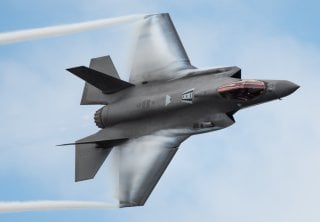History Proves Gutting the F-35 Fighter Would Be a Tragic Mistake
Some people may worry that the rapid rise of an emerging Air Force sixth-generation fighter jet might lead some to favor that type of program cut.
Few who follow defense issues are likely to forget the unexpected and massive cut to the F-22 Raptor program a few years ago. The U.S. military made this move during the height of the War on Terror. It was eventually regarded as a massive mistake given the emergence of great power threats to the U.S. Air Force. After the F-22 program was prematurely trimmed down to 187 aircraft, the combatant commander demand for the stealth fighters went on to be massive. In fact, the F-22 cut might easily be considered one of the biggest U.S. military strategic mistakes in the last twenty years. And, for some insane reason, some want to repeat this tragedy on a massive scale with the F-35 Joint Strike Fighter.
Another Mistake in the Offing? It Would Be Tragic.
Could that same mistake be possible with the F-35 program given all of the unfair and criticism and phony concerns about costs and F-35 sustainment? What happened with the F-22 jet program years ago raises a serious concern for senior members of Congress who are seeking to avoid any kind of large-scale F-35 reduction.
“I hate to keep comparing—my fear for what might be happening to the F-35 with what has happened and did happen back in about 2004 with the F-22,” Sen. James Inhofe (R-Okla.), ranking member of the Senate Armed Services Committee, said during a budget hearing with senior members of the Air Force earlier this year.
What might happen if there was a large cut to the F-35 program? Fewer F-35 jets in the sky, coupled with an insufficient number of F-22s, could create a huge strategic problem and push the Air Force to operate larger numbers of fourth-generation aircraft that have nearly no ability to wage war against great power competitors like Russia and China. Both nations have robust air defense networks and now their own fifth-generation planes that would take down large numbers of F-15s and F-16s. Simply stated, we would face a future where the U.S. military would be flying obsolete fighters for decades to come that are way past their prime that would cost billions to maintain and repair.
We must also consider the ability of U.S. F-35 jets to network and for multinational F-35 jets to network with them when executing a mission could be greatly compromised, and perhaps eliminated. After all, an ability to fly in formation, mass, disperse, interoperate and network is a key advantage of the U.S. allies investing in the F-35 program. Killing such a feature would surely raise overall costs, not cut them.
Other Silly F-35 Cut Logic
Alongside concerns about a major cut to the F-35 program, some people may worry that the rapid rise of an emerging Air Force sixth-generation fighter jet might lead some to favor that type of program cut. Such thinking, however, may be greatly misguided given current future plans for both the F-35 jet and sixth-generation aircraft. The Air Force has been clear that the F-35 jet and sixth-generation jet are intended to complement one another. It appears the jets are indeed intended to be distinct aircraft with different mission sets and technical characteristics.
While very little is known about the configuration, performance parameters, or mission profile for the new sixth-generation aircraft, there has been evidence that plans for the jet aligned with using it to replace an F-22 jet and not as an F-35 jet substitute.
This transition seems even more apparent now, in light of the recent revelation that the F-22 jet will begin to sunset in 2030, several decades ahead of earlier projections as it has gone through numerous upgrades.
Interestingly, growing enthusiasm for the now airborne sixth-generation stealth fighter jet does not seem to be inspiring any comments about scaling back the F-35 jet. In fact, the opposite may be true, given that the two aircraft are intended to fly alongside and support one another. Engineering a next-generation F-22-like sixth-generation aircraft in no way diminishes the need for F-35 jets.
The F-35 Is Here To Stay
The simple logic is that considering the number of planes the U.S. military will replace with the F-35, the threats from Russia and China the stealth fighter is built to take on, and the multinational coalition now spending billions to acquire the plane, the F-35 should indeed have a bright future. We should learn the lesson from the F-22 and understand that doing the same would create tremendous problems for the U.S. military when Moscow and Beijing could only dream of having such a fighter jet, as they seem all too eager to emulate it.
Kris Osborn is the defense editor for the National Interest. Osborn previously served at the Pentagon as a Highly Qualified Expert with the Office of the Assistant Secretary of the Army—Acquisition, Logistics & Technology. Osborn has also worked as an anchor and on-air military specialist at national TV networks. He has appeared as a guest military expert on Fox News, MSNBC, The Military Channel, and The History Channel. He also has a Master’s Degree in Comparative Literature from Columbia University.
Image: Flickr.

